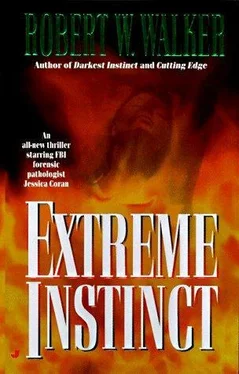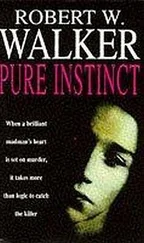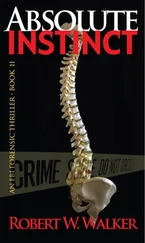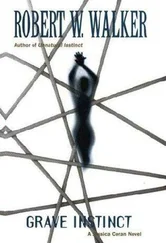Robert Walker - Extreme Instinct
Здесь есть возможность читать онлайн «Robert Walker - Extreme Instinct» весь текст электронной книги совершенно бесплатно (целиком полную версию без сокращений). В некоторых случаях можно слушать аудио, скачать через торрент в формате fb2 и присутствует краткое содержание. Жанр: Триллер, на английском языке. Описание произведения, (предисловие) а так же отзывы посетителей доступны на портале библиотеки ЛибКат.
- Название:Extreme Instinct
- Автор:
- Жанр:
- Год:неизвестен
- ISBN:нет данных
- Рейтинг книги:3 / 5. Голосов: 1
-
Избранное:Добавить в избранное
- Отзывы:
-
Ваша оценка:
- 60
- 1
- 2
- 3
- 4
- 5
Extreme Instinct: краткое содержание, описание и аннотация
Предлагаем к чтению аннотацию, описание, краткое содержание или предисловие (зависит от того, что написал сам автор книги «Extreme Instinct»). Если вы не нашли необходимую информацию о книге — напишите в комментариях, мы постараемся отыскать её.
Extreme Instinct — читать онлайн бесплатно полную книгу (весь текст) целиком
Ниже представлен текст книги, разбитый по страницам. Система сохранения места последней прочитанной страницы, позволяет с удобством читать онлайн бесплатно книгу «Extreme Instinct», без необходимости каждый раз заново искать на чём Вы остановились. Поставьте закладку, и сможете в любой момент перейти на страницу, на которой закончили чтение.
Интервал:
Закладка:
Repasi promptly agreed, saying, "Yes, lack of such a response doesn't necessarily indicate that the burn was postmortem. I have had occasion to view third-degree burns incurred by Vietnam veterans in which the patients died two and three days later. In some of these cases, there was no inflammatory reaction whatsoever."
Jessica agreed now, adding, "Due, presumably, to heat thrombosis of the dermal vessels."
"Such that inflammatory cells could not reach the area of the burn and produce a reaction to begin with," finished Repasi.
Jessica thought that perhaps J. T. ought to have remained; he might well have learned something about the irregular nature of burn pathology.
"In Mr. Martin's case, it is presumed he was alive when he died due to witness testimony, namely Dr. Coran," said Repasi for the record.
"It may also be of interest that the skin has split open, revealing exposed muscle across the upper torso and upper extremities, while skin over the back is perfectly preserved. Where the skin is completely burned away, underlying muscles have ruptured due to the intensity of the heat," added Jessica.
Burned bone shone as gray-white with a fine, superficial network of fractures on the cortical surface. Repasi noted this for the shoulder bone and collarbone as well as the skull. With his gloved hand, he put slight pressure on a section of skull thus discolored, and it crumbled at his touch. He noted this for the record. "The outer table of the exposed cranial vault," he said, pausing, "reveals a network of fine, crisscrossing heat fractures."
Both examiners knew that it was extremely hard to burn a body, due to its high water content, and that to do the damage the Phantom had inflicted on Martin required a superheated energy source. Portions of the abdominal wall were burned away as well, exposing the viscera. The internal organs appeared charred, seared.
''In the autopsy on Chris Lorentian, who died from similar inflicted wounds," Jessica said, "there was evidence of an antemortem epidural hematoma."
Repasi added, "We find a similar blow to the head before death in Martin; there is a sizable postmortem epidural hematoma present. Not an uncommon sight in severely burned bodies. See here, Jessica, the chocolate brown color, crumbly, with its telltale honeycombed appearance."
"Yes, I see it. Large, fairly thick, overlying the frontal lobe, extending toward the occipital area."
He lifted a tiny ruler to it and asked an assistant to snap a picture, and for the record he announced, ''Yes, large at one point five centimeters."
"Good catch, Doctor." Jessica turned off the recorder for a word with Dr. Repasi. "Karl, I didn't know your specialty was burn victims."
''One of many,'' he replied with a grin beneath his surgical mask. "Shall we have a look-see at the larynx and trachea? Examine for carbon monoxide intoxication?"
"I prefer the term smoke inhalation, Doctor, but yes."
"Semantics," he parried and scalpeled at the same time, opening up the charred throat and dissecting the larynx and trachea, which, while fire-blackened and fractured on the outside, remained intact.
Too many people in the scientific community, as far as Jessica was concerned, used the terms of the profession too loosely, such as making carbon monoxide poisoning synonymous with smoke inhalation. A number of important factors other than the presence of carbon monoxide in the blood might cause death by smoke inhalation, such as oxygen deprivation due to consumption of oxygen by the fire itself, cyanide, free radicals, and the old standby to fall back on, nonspecific toxic substances. Jessica knew that in cases of self-immolation, carbon monoxide, as a general rule, was not elevated, since it was a flash fire. In cases involving explosives or gasoline fires, carbon monoxide levels in the blood were usually found to be in the so-called normal range. This held true even if the body were severely charred. Every fire, in fact, was unique, and each created its own unique mysteries. Of course, Repasi knew this as well as she.
She spoke again into the recorder, saying, "Smoke inhalation reveals soot in the nostrils and mouth, but this alone is no indication the victim was alive when the fire began. Any further look into the breathing apparatus will not change that fact."
But Repasi, ever the perfectionist, wanted to see the results of this fire to the windpipe as well. He announced what his scalpel now sliced through and why for the record. The soot had not coated the larynx, trachea, or bronchi, but both doctors took this in stride.
"Well, clean as a whistle except for the gristle," quipped Repasi. "What do you make of that, Dr. Coran?"
"Absence of soot in these areas in a flash fire is not uncommon, and it does not necessarily mean that Martin was dead prior to the blaze."
"Quite right. I've seen numerous cases in which no soot appeared in these deeper areas, and yet analysis of blood carbon monoxide revealed lethal levels. Unfortunately, blisters or the absence thereof," continued Repasi, "do not indicate that the deceased was alive at the time the burns were incurred either, since they can be produced postmortem."
Jessica knew that many people, medical people included, coroners and pathologists and some medical examiners included, mistakenly believed that if blisters or burns were surrounded by an erythematous-red-rim, then this clearly indicated that the victim was alive at the time the burns were incurred. This was blatantly false. Blisters with such red rims had now been produced on dead bodies at the FBI's famous, or infamous, "Body Farm" in Tennessee. Both she and Repasi knew that heat applied to skin caused contraction of dermal capillaries, and this forced blood to the periphery of the blister, simulating an antemortem hyperemic inflammatory response. An autopsy on such a body proved the worst kind of pathology. Fire did awful things to flesh, creating leathery, wood-grainlike swirls, like some mad tattoo artists had been allowed to go to work on the dead man. Jessica recognized this configuration as the result of actual contact with flame, that they were again dealing with a "flash" burn.
The extent of the burn was indicated as the percent of total surface area involved by the thermal injury, and chemical burns from the gas used caused even deeper, thicker blotches of mottled skin tissue. The percentage of total surface area burned was quickly determined using the rule of nines. Jessica, using the typical conventional thinking, considered the total body surface as 100 percent, meaning the head was 9 percent, as it was completely burned away to the bone, leaving no features. The arms or upper extremities represented 9 percent each. The front of the torso, also extremely badly damaged, counted for an additional 18 percent. The back, which was not burned badly at all, since it was protected by the victim's weight against the bed, also represented 18 percent. Each lower extremity totaled 18 percent apiece, while the neck amounted to 1 percent, equaling an even 100 percent. Martin's body was burned over 82 percent of its surface. His burns were the worst kind, third- and fourth-degree, or as Repasi's nomenclature had it, a combination of partial-and full-thickness burns. In third-degree burns there was coagulation necrosis of the epidermis and dermis with complete destruction to the dermal appendages. Most of Martin's lesions were brown and blackened, the result of charring and eschar formation. If he had survived the fire, the smoke inhalation, the shock, the dehydration, and the bursting blood vessels, this blackened skin would have healed as scar tissue, but at his advanced age, even if he had lived, he would likely be dead within hours or days. Other burns, fourth-degree burns, appeared as ashen white leather. There were no red blisters. The fire was too intense for the cherry-red burns usually associated with fire and skin, for Martin's burns were incinerating injuries extending deeper than the skin.
Читать дальшеИнтервал:
Закладка:
Похожие книги на «Extreme Instinct»
Представляем Вашему вниманию похожие книги на «Extreme Instinct» списком для выбора. Мы отобрали схожую по названию и смыслу литературу в надежде предоставить читателям больше вариантов отыскать новые, интересные, ещё непрочитанные произведения.
Обсуждение, отзывы о книге «Extreme Instinct» и просто собственные мнения читателей. Оставьте ваши комментарии, напишите, что Вы думаете о произведении, его смысле или главных героях. Укажите что конкретно понравилось, а что нет, и почему Вы так считаете.












